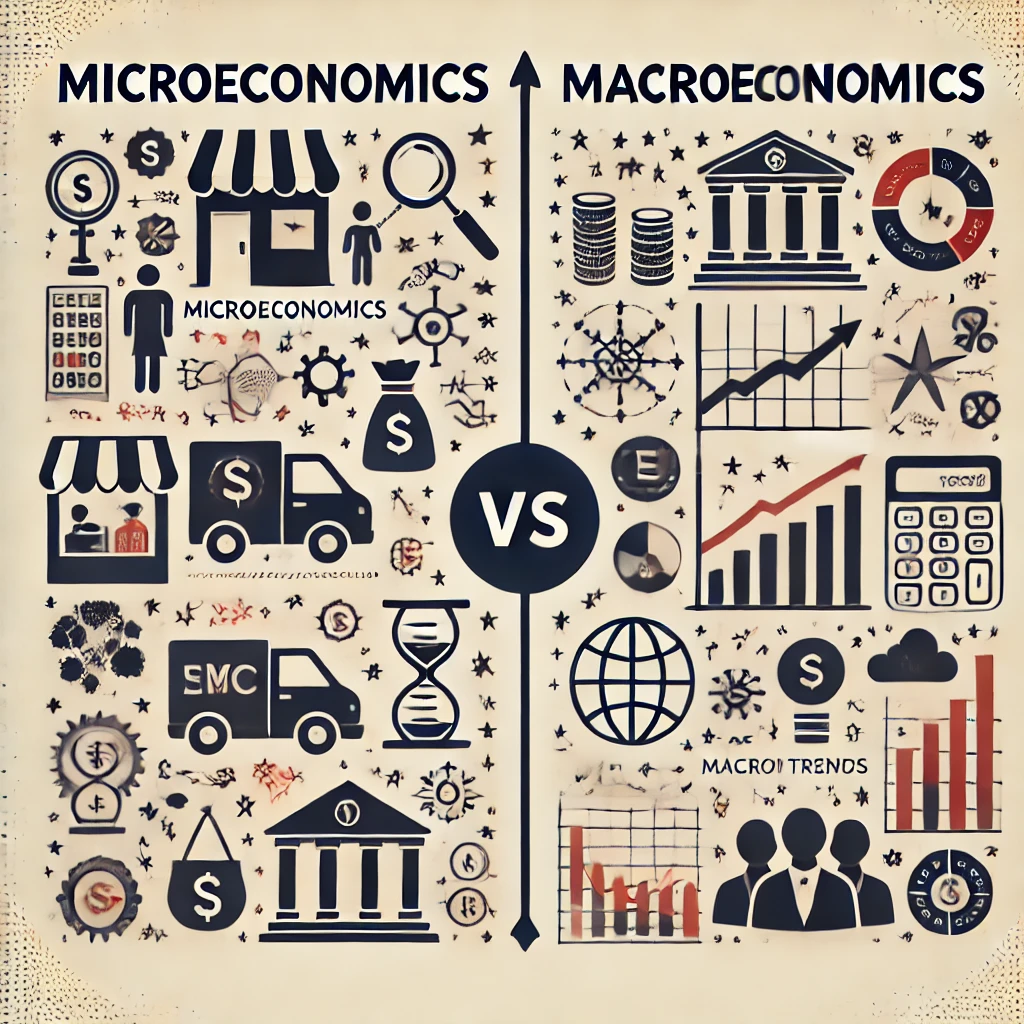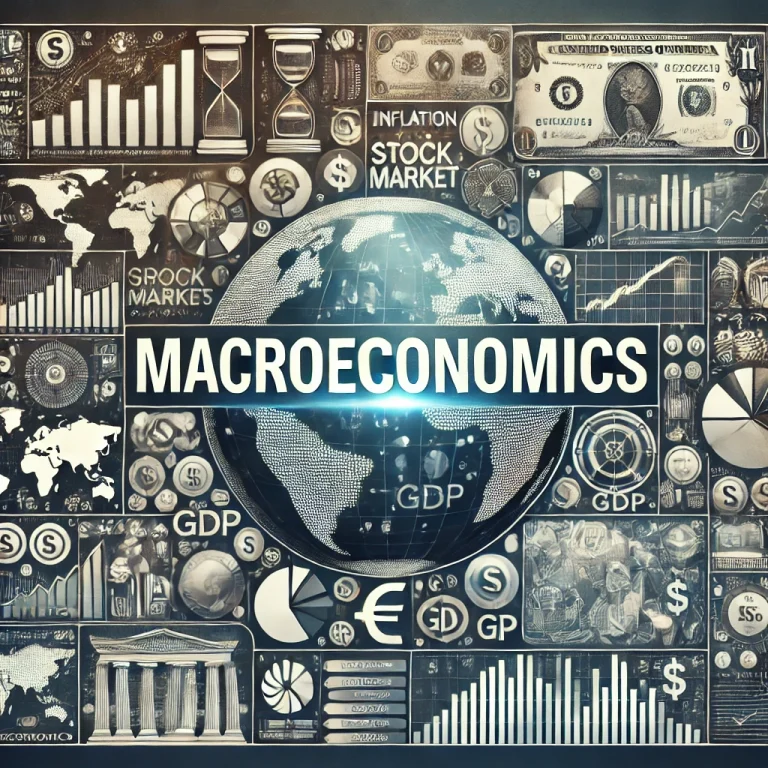Macroeconomics is the study area of economics that deals with the performance and behavior of a whole economy rather than individual markets. It focuses on aggregate variables like national income, total employment, inflation, and economic growth. This article will discuss macroeconomics, its importance, evolution, and scope, among other things, in order to provide a comprehensive understanding of the topic.
What is Macroeconomics?
Macroeconomics is the study of the economy as a whole. The factors analyzed are large-scale economic parameters, such as gross domestic product (GDP), unemployment, and inflation. In contrast, macroeconomics considers both decisions related to single units and the business as a whole. Aggregate demand and supply and how fiscal and monetary policies influence the economy are measured in macroeconomics, along with how they interact to determine economic growth and stability.
Who is the Father of Macroeconomics?
Often, the title “Father of Macroeconomics” is bestowed on John Maynard Keynes, the British economist who is credited with the base of much of the current work in macroeconomic theory. Keynes’s masterwork, done in the 1930s during the then Great Depression, revolutionized economics by turning their attention from details in microeconomics to broader economic forces shaping national economies. His book, The General Theory of Employment, Interest, and Money, published in 1936, challenged all the classical economic theories as it propounded government interference as an intervention to control the economy.
Influence of Keynesian Economics
- Keynes said that, in times of recession, expenditure should be increased by the government to raise demand.
- Due to his theory, modern fiscal policy came into being. It formulated the usage of budgets of the government as an instrument for regulating cycles of the economy.
History of Macroeconomics
The history of macroeconomics can trace its roots all the way back to the earliest classical economists who laid down a foundation by researching how markets work at a broad scale, like Adam Smith and David Ricardo. However, macroeconomics as we understand it today was defined as an independent discipline in the 20th century, more particularly after the collapse after the Great Depression.
Key Historical Milestones
- Classical Economics (18th – 19th Century): Early thinkers looked at supply, demand, and production but did not separate between macro and micro types
- Keynesian Revolution 1930s: Keynes’s theory of the depression as an explanation for persistent unemployment and economic stagnation gave rise to macroeconomic analysis.
- Post-WWII Expansion: National income accounting and models to control inflation, unemployment, and growth.
- Neo-Classical Synthesis (1950s – 1960s): Economist Paul Samuelson managed to amalgamate much of the classical and Keynesian literature to yield the framework in use today.
- Modern Macroeconomics (1970s – Present): Concepts like rational expectations, supply-side economics, and monetarism as developed by thinkers like Milton Friedman have enriched macroeconomic theory.

Scope of Macroeconomics
The scope of the field is broad, encompassing elements that help influence the general economy as a whole. These areas explain how an economy works, how policymakers can enhance the performance of an economy, and how an economy can cope with economic shocks.
- Aggregate Demand and Supply: Explaining how aggregate demand and supply in the economy is relevant to general price level and output.
- National Income: It explores how national wealth is measured, including the GDP, Gross National Product, and Net National Product.
- Inflation and Deflation: This explains why an economy can experience a rise in prices or a fall in prices and its influence on an economy.
- Unemployment: Studies the causes of unemployment and what needs to be done for full employment.
- Fiscal and Monetary Policies: It explores how these policies are utilized by governments and central banks to affect economic activities.
- Economic Growth and Development: It is the long-term growth of an economy and improved standards of living, due to various factors.
Importance of Macroeconomics
Macroeconomics plays a crucial role in shaping national and international economic policies. Its relevance extends to understanding complex economic relationships and guiding policymakers in addressing various challenges.
Why Macroeconomics Matters:
- Economic Stability: It helps design policies for stable growth, controlling inflation, and decreasing unemployment.
- Policy Formulation: The government relies on macroeconomic data to design policies to steer the economy and sustain balanced growth.
- Forecasting Economy Trends: Macroeconomic models enable the forecasting of future economic trends and facilitate long-run planning.
- Understanding Global Interdependence: Macroeconomics provides insight into how global trade and finance are interconnected with domestic economies in an increasingly interdependent world.

Nature of Macroeconomics
Macroeconomics is either positive or normative in nature. Positive macroeconomics explains how the economy works, while normative macroeconomics advises how the economy ought to be managed by making certain policy recommendations.
- Aggregative: It takes an aggregate approach to the study of the economy, meaning total income, output, employment, and general price levels are studied.
- Dynamic: This type of economics traces changes in economic variables over time. In particular, it looks at how changes in demand, supply, or policy affect growth and stability.
- Policy-Oriented: Macroeconomic theories provide fiscal and monetary policies, public finance, as well as trade policies.
- Interdisciplinary: It draws from other fields, such as politics, history, and sociology, to understand broader economic trends and issues.
Microeconomics vs. Macroeconomics
While both microeconomics and macroeconomics are integral parts of economic theory, they differ in scope, focus, and application.
| Aspect | Microeconomics | Macroeconomics |
|---|---|---|
| Scope | Individual markets and decisions | Entire economies and aggregate variables |
| Focus | Price determination, resource allocation | National income, inflation, unemployment |
| Approach | Bottom-up, focusing on individual choices | Top-down, focusing on aggregate outcomes |
| Objective | Efficiency and optimization | Economic stability and growth |
| Policies | Deals with market structures, competition | Deals with fiscal, monetary, and trade policies |
Conclusion
Macroeconomics constitutes the background for a more generalist understanding of economic issues and in turn provides a basis for understanding a much wider economic environment based on national income, unemployment, inflation, and economic growth. For that purpose, tools and models developed by macroeconomists can lead a government and policymakers toward more prudent decisions in stabilizing and growing their economies, especially during crisis times. Therefore, through the knowledge of central macroeconomic concepts, people and organizations can also make better decisions in their everyday lives and understand how wider economic forces shape their actions.
Macroeconomics FAQs
What is the difference between microeconomics and macroeconomics?
Microeconomics deals with individual markets, while macroeconomics studies the economy as a whole.
Who is considered the father of macroeconomics?
John Maynard Keynes is regarded as the father of modern macroeconomics.
Why is macroeconomics important for policy-making?
It provides the framework to design policies that regulate economic growth, control inflation, and manage unemployment.
What are the major objectives of macroeconomic policy?
The key objectives are economic growth, full employment, price stability, and a balanced budget.
What is the scope of macroeconomics?
Macroeconomics encompasses national income, aggregate demand and supply, inflation, unemployment, fiscal and monetary policies, and economic growth.


